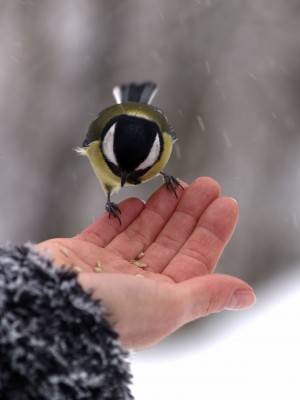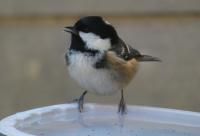- Home
- Special Offers
- New Products
- FAQs
- Customer Video Gallery
- Customer Photo Gallery
- Bird Facts
- Bird Food Blog
- Bird Information
- Feeding Advice
- Small Animal Information
- A to Z of Guinea Pigs
- A to Z of Hamsters
- A to Z of Rabbits
- Basic Care for Guinea Pigs
- Basic Care for Hamsters
- Basic Care for Rabbits
- Basic care for Chinchillas
- Basic care for Ferrets
- Basic care for Gerbils
- Basic care for Mice
- Basic care for Rats
- Buying a Healthy Small Animal
- Does your Reptile need a Licence
- Equipment for Ferrets
- Equipment for Hamsters
- Equipment for Mice
- Equipment for your Chinchilla
- Equipment for your Gerbil
- Equipment for your Guinea Pig
- Equipment for your Rabbit
- Keeping a House Rabbit
- Dog Information
- Cat Information
- Customer Information
- Bird Food
- Small Animals Food
- Pond Fish Food
- Dog Food
- Cat Food
- My Account
| Tweet |

|
How To Feed Wild Birds
Feeding can be achieved in numerous ways, each dependant on the room you have available but the most common and popular are directly on the ground or ground feeding platform, on Bird Tables and in suitable Feeders. It is important that food isn’t allowed to go stale and mouldy and that feeding areas are kept clean.
 Feeding on the ground or from a ground platform is ideal for birds such as Blackbird, Thrushand Robins. These birds are often referred to as soft bills and prefer softer foods such as Mealworms and Insects, berries and Raisins and Suet Pellets.
Feeding on the ground or from a ground platform is ideal for birds such as Blackbird, Thrushand Robins. These birds are often referred to as soft bills and prefer softer foods such as Mealworms and Insects, berries and Raisins and Suet Pellets.
Table feeding attracts a wide range of wild birds and is suitable for most types of food. Tables can be simple or elaborate but make sure they are easy to maintain and clean. Foods can be placed directly on the table surface of hung from the sides in suitable feeders or a mix of both.
Bird Feeders come in several designs and materials from simple plastic ones to wooden ones to high quality long lasting metal varieties. The most common types are Seed Feeders, Peanut Feeders, Fat Ball Feeders, Suet Block/Cake Feeders and Mealworm Feeders .
Seed feeders are suitable for Seed Mixes and Sunflower Hearts and will tend to attract clinging birds such as Tits, Greenfinch and Siskin.
As the name suggest, Peanut Feeders are suitable for Peanuts, Sunflower Hearts or Seed Mixes and Suet Pellets. They will attract Tits, Nuthatch, Finches and even Woodpeckers amongst others.
Fat Balls can be placed in Fat Ball Feeders which come in many different designs and sizes, but all serve the same basic function and allow clinging birds easy access to this high energy source of food.
Suet Block Feeders and Suet Cake Feeders are specially designed to hold these types of products and allow wild birds easy access to these energy rich foods.
Mealworm Feeders are designed to allow the feeding of live or Dried Mealworms or other larvae to wild birds and are a favourite of both Robins and Blackbirds along with many other insect loving birds.
The basic design of a Seed Feeder is typically that of a clear plastic or acrylic tube with holes at intervals into which feeding points are inserted with a lid to keep out rainwater and a handle or chain for hanging a Peanut Feeder can be very similar, typically also tubular, but instead of plastic or acrylic the tube is replaced with one made from a metal mesh of approximately 6mm gaps. Other features may include an integral water dish, perching points, umbrella lids to keep out even more rain, mesh guard cage to keep feeding birds safe and squirrels at bay
However you feed wild birds, good hygiene is very important to help maintain healthy visitors, clean up uneaten food and wash and disinfect feeders, tables and bird baths regularly.
 Feeding on the ground or from a ground platform is ideal for birds such as Blackbird, Thrushand Robins. These birds are often referred to as soft bills and prefer softer foods such as Mealworms and Insects, berries and Raisins and Suet Pellets.
Feeding on the ground or from a ground platform is ideal for birds such as Blackbird, Thrushand Robins. These birds are often referred to as soft bills and prefer softer foods such as Mealworms and Insects, berries and Raisins and Suet Pellets.Table feeding attracts a wide range of wild birds and is suitable for most types of food. Tables can be simple or elaborate but make sure they are easy to maintain and clean. Foods can be placed directly on the table surface of hung from the sides in suitable feeders or a mix of both.
Bird Feeders come in several designs and materials from simple plastic ones to wooden ones to high quality long lasting metal varieties. The most common types are Seed Feeders, Peanut Feeders, Fat Ball Feeders, Suet Block/Cake Feeders and Mealworm Feeders .
Seed feeders are suitable for Seed Mixes and Sunflower Hearts and will tend to attract clinging birds such as Tits, Greenfinch and Siskin.
As the name suggest, Peanut Feeders are suitable for Peanuts, Sunflower Hearts or Seed Mixes and Suet Pellets. They will attract Tits, Nuthatch, Finches and even Woodpeckers amongst others.
Fat Balls can be placed in Fat Ball Feeders which come in many different designs and sizes, but all serve the same basic function and allow clinging birds easy access to this high energy source of food.
Suet Block Feeders and Suet Cake Feeders are specially designed to hold these types of products and allow wild birds easy access to these energy rich foods.
Mealworm Feeders are designed to allow the feeding of live or Dried Mealworms or other larvae to wild birds and are a favourite of both Robins and Blackbirds along with many other insect loving birds.
The basic design of a Seed Feeder is typically that of a clear plastic or acrylic tube with holes at intervals into which feeding points are inserted with a lid to keep out rainwater and a handle or chain for hanging a Peanut Feeder can be very similar, typically also tubular, but instead of plastic or acrylic the tube is replaced with one made from a metal mesh of approximately 6mm gaps. Other features may include an integral water dish, perching points, umbrella lids to keep out even more rain, mesh guard cage to keep feeding birds safe and squirrels at bay
However you feed wild birds, good hygiene is very important to help maintain healthy visitors, clean up uneaten food and wash and disinfect feeders, tables and bird baths regularly.







